27 badass electric guitars under £400
UPDATED: Affordable workhorse axes reviewed
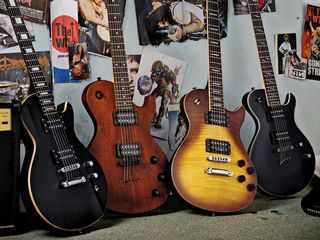
27 badass electric guitars under £400
UPDATE: Like the cool electrics under £300 update earlier this week, we've added two new humbucker-loaded models to this gallery of slightly more expensive axes. See them both on the next two slides of this gallery or, if it's your first time here, keep on scrolling for a selection of guitars to suit every player - all under £400...
If £300 is a ceiling price for beginners (a price range we've finely tooth-combed with the 21 best, and 22 alternative electrics), digging deeper for that extra ton is perhaps best left to improving players. While the tool will never maketh the guitarist, a better axe will do anything but hinder your developing technique.
Here then, hand-picked from the pages of Total Guitar, are 27 badass electric guitars under £400. We're still in affordable territory, but like the jump from £200 to £300, the upgrades in materials, pickups and finishes for an extra £100 are noticeable.
First up: Hamer Monaco XT
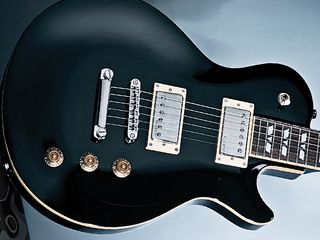
Hamer Monaco XT £346
With a name that evokes playboys and princes, but a price suggesting pub-rockers and paupers, the Monaco XT might be sending out mixed messages, but it’s always reassuring to see the Hamer logo on a headstock.
In our experience, the boys from Chicago don’t drop the ball and from first inspections this singlecut looks and feels like a heavyweight choice. We mean that literally: compared to its rivals, this beast is a back-breaker in the Les Paul tradition, with a deep-pan nato body that had better pay us back with never-ending sustain.
In truth, all that timber is irritating when you sit down, with the Monaco’s weight distribution meaning it fights desperately to slide off your lap. But stood up with an (industrial-strength) strap, you’ll find this an excellent choice if you’re stuck in the ‘50s and crave a chunky neck, an idiot-proof tailpiece and the most boneheaded pickup configuration known to man.
It’s not rocket science. It does sound good, though. Hamer’s good pickup reputation is upheld by these twin items, which don’t mess about with coil-taps and offer a ‘classic’ tone. It’s buttery and rounded when clean at the neck, with a toppy sandpaper bridge sneer as you push the gain. And, yes, the sustain is monstrous, letting you hang notes out there for ice ages.
Verdict
It’s not quite a Hamer of the gods, then, but it is a watertight Les Paul substitute.
4 out of 5
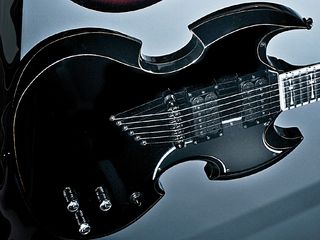
JTR Elvira EV30 £345
While electrics are often referred to as ‘axes’, designer JT Riboloff has run with the concept, creating a model that looks like it could be wielded by a berserker. “I’ve seen other companies do something similar,” he notes of this SG-with-bite-marks, “but they always make it a little blockier, bigger, droopier.”
In theory, there are many plus points, with the ex-Gibson man referring us to the EV30’s one-of-a-kind neck profile and double hotwired humbuckers voiced to combine high output and clarity. The physical reality is almost as good.
We’d be concerned about that top-fret joint on the road, but there’s much to recommend the set mahogany neck itself. It makes an immediate impression with a wide, flat carve and double-octave fingerboard. It plays fast and smooth, and access is stellar, although the lack of a vibrato makes us question if this will do it for the shred brigade.
Verdict
The EV30’s tone is generally strong. As with many metal-leaning models, the clean tone’s just decent, a warm and mid-heavy voice that lacks a little character, but it’s pretty adaptable thanks to the pickup blend control.
But Riboloff is right about the overdriven punch: it’s dark and heavy as hell, yet never sinks into the tonal quagmire that defines a below-par humbucker guitar.
4 out of 5
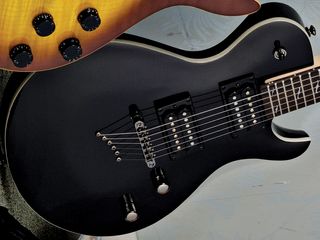
Dean Deceiver X £305
The Razorback generation is growing up, but Dean’s catalogue is ready to cater for them, with the new-ish Deceiver X offering such a classic vibe and old-school features that it should probably say ‘Keep Out Of Reach Of Children’ on the box.
Turns out this model is pretty deceptive: it comes on like a textbook ‘50s singlecut, but then you spot the skinny mahogany body, Fender-style 25.5-inch scale, bolt-on neck and shred-style 24 frets. Those factors make a big physical difference, and here’s where the Deceiver gets divisive.
We love the smooth-playing C-profile and only a fool sniffs at two octaves… but Les Paul fans might miss the free-and-easy bends of a shorter-scale neck, while hitting the fat strings at the top frets ain’t easy without finger extensions. Still, there’s potential for down-tuning without too much slack, and that’s worth factoring in if you like your riffs bowel-quaking and doom-laden.
Verdict
The Deceiver’s slim tablet of a body doesn’t hang on to sustain as well as some, but the tone itself is quality: all the brown warmth of mahogany, but counterbalanced by the bite of the maple neck; all fattened and frayed by a pair of better-than-average own-brand humbuckers whose strongest suit is a mid-heavy classic distortion.
It’s definitely good enough for live, and at a push for the studio, and at £305, you’d have to agree that means the X hits the spot. Question is, would it sustain you for your whole career?
4 out of 5
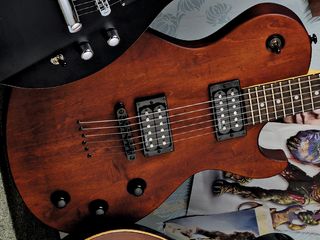
Schecter Omen Solo-6 £349
Bargain is a slippery term. At £349, this guitar is admittedly nudging into the mid market, but it’s hard to count the pennies when faced with the beauty of that singlecut body, which looks like an offcut from an Edwardian tea chest. If this guitar plays as good as it looks, it’s a snip.
After 35 years in the game, Schecter isn’t about to fluff the basics. As such, there’s much to enjoy about this axe’s performance, with the flat neck and XJ frets meaning you can play a lot of notes very fast, while the beefy body supplies similarly hefty sustain.
It’s a good compromise between a puny shred axe and a meat-and-potatoes rocker, and nicely built, too, with recessed dials, rugged bolt-neck and idiot-proof bridge also signposting a life on the road. But this guitar ain’t quite perfect…
Verdict
You want noise and fury from a rock singlecut, and with its twin Diamond pickups wound to buggery, the Schecter delivers that in spades, making everything you play sound ragged, angry and a bit like Humble Pie (the tone even breaks up on the clean channel).
That’s great, but we also want a mellow tonality for weeping blues, and the Omen isn’t so convincing there, with the basswood body failing to supply the warmth of mahogany and even the neck pickup sounding a bit ‘in-your-face’. It’s a great axe, but sometimes you just want to tell it to, y’know, calm down.
4 out of 5
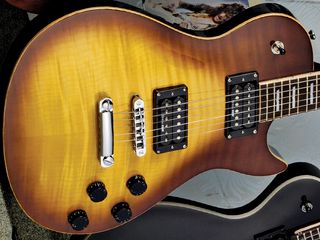
Washburn WIN-PRO £340
It’s easy to take the Washburn Idol for granted. This singlecut design has been so all-pervasive in the post-millennium that us grizzled gear-hounds are practically numb to it… until we play one and are reminded why it’s so damn popular.
From our opening strum, the WIN-PRO started prising the gold medal from its rivals’ fingers. By the time our final note faded, we were ready to take it home.
Where’s the £340 gone? Well, the raw materials are dynamite (mahogany body and neck plus maple cap equals a ‘proper’ Les Paul configuration) and they’ve been put together with flair and minimal fuss.
The neck is cool and just what you want as a singlecut fanatic: it doesn’t try to chase the shred dollar, but is perfect for wide vibrato, expressive bends and fast rock/ blues soloing.
Duncan humbuckers can be seen as the poor relation of ‘real’ Seymour Duncan units, but they don’t sound it here, turning in smooth, mellow, almost jazzy clean tones that have sonic weight but never turn soupy. The filth is quality, too: punchy and characterful, and gig-changingly great when you select the bridge, dial up some reverb and evoke the spirit of Gary Moore.
Verdict
The WIN-PRO gets ticks in all the boxes: big name on the headstock, small price on the tag, bags of feel and buckets of tone. Luthiers take note. This is how you make a budget singlecut fly.
5 out of 5
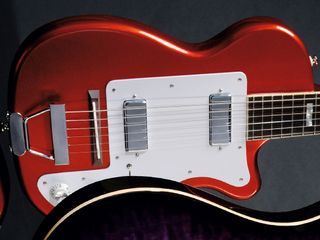
Eastwood Airline H44 Deluxe £349
We’ve got a full-on monster chubby for Eastwood’s reissues of forgotten classics. There we’ve said it: we feel better. While the original axes that its reissues are based on can be expensive (and hard to find), Eastwood’s guitars are affordable and generally better built than the originals.
According to Eastwood, the 1950s Stratotone H44 guitar is “one of the coolest blues/slide guitars ever made. We’ve kept 99 percent of this baby true to the original, but we’ve improved the pickups and upgraded to an adjustable neck.” But was it worth all that effort?
The H44’s neck is so chubby it could give flab-Nazi Gillian McKeith sleepless nights. You’d think its considerable girth would make it tough to play, but fat necks can feel surprisingly comfortable. The H44 sweetens the deal with a low action.
Verdict
This guitar is a blast to play. Thanks to the solid ash body and twin mini humbuckers this sweet little Airline sounds as fat as it feels. We spent most of our time playing slide on the H44 (it absolutely rules for slide!) but it’ll handle anything you throw at it: trashy blues, punk, you name it.
4 out of 5
Pros: It’s pretty, awesome playability.
Cons: Too quirky for some?
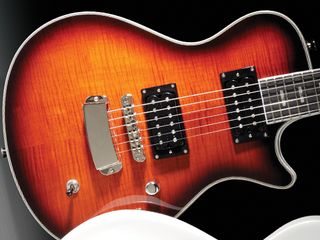
Hagstrom Ultra Swede £399
Behind the façade of pigtails and flat-packed furniture, the Swedes are a nation of rock pigs, exporting the planet’s fastest shredders and its most underrated guitar brand. Ruined by the Far Eastern copy boom in 1983, and resurrected in 2006, it’s been a bumpy ride but Hagstrom reckons this “little monster” will “grab the competition by the neck.”
Hagstrom prides itself on physical flair, and with some justification, because despite familiar full-frontal contours the Swede is slimmer than a LP and plays faster, with the H-Expander truss rod resulting in a flat, thin, fast profile whose low action requires a mere tickle to sound notes.
It’s not a ‘shred’ axe; to describe it thus would do a disservice to the clean tone, which is fat and proud, and the frayed, bottom-heavy old-school Zep swagger that is delivered at more ‘classic’ overdrive levels. Shredders may struggle to get a razorblade lead tone without splitting the coils (a mere gripe).
Verdict
We love the Swede: it’s a cool model by a cult hero that will get your bandmates crowding round in rehearsals and knock them out when you start playing. No £399 guitar is perfect: this could use more bite at the bridge and its slim body costs you sustain. But we think you’ll hold onto the Swede as a spare or live axe as you progress.
Not bad for a week’s wages.
5 out of 5
Pros: Versatile tone, feel, vintage looks.
Cons: A bit more bridge bite needed.
Buy: Hagstrom Ultra Swede is currently available from Thomann
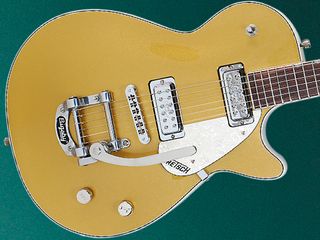
Gretsch Electromatic Pro Jet £399
The Electromatic range is designed to put killer looking guitars into the hands of players that wouldn’t normally be able to afford a Gretsch. The range includes a 6120-style semi-acoustic for budget conscious rockabilly fans, and a sparkly double-neck guitar.
The Pro Jet takes its inspiration from one of the coolest guitars ever made, the Duo Jet. Launched in the ‘50s the Duo Jet has become an ultra-desirable classic thanks to Beatle George Harrison who played one on the band’s brilliant 1963 debut album Please Please Me.
Original Duo Jets will cost you both arms and legs and even a Japanese re-issue will relieve you of over a grand. So considering the price it’s amazing to find that Gretsch has stayed pretty faithful to the construction of the original Duo Jet.
Verdict
The mahogany and maple body is just like the real deal and the Pro Jet has a glued neck, which is great to see at less than 400 quid. The only area we can see room for improvement is in the pickups. They do their job well, but we want a guitar that looks this cool to blow us away when we plug in. The Pro Jet is more chunky Les Paul tone than the ‘50s rockabilly bite we expected.
That aside we’re with The Beatles on this one. Do we like the Pro Jet? Yeah, yeah, yeah.
4 out of 5
Pros: Looks super cool.
Cons: Pickups need more bite.
Buy: Gretsch Electromatic Pro Jet is currently available from Thomann
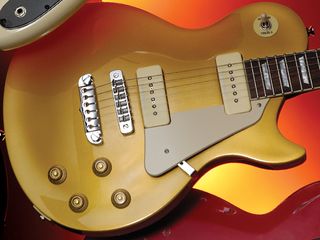
Aria PE-90 £389
For most working musicians, the only Goldtop within budget is a pint of milk. If that’s you, the Aria PE-90 demands investigation, sticking to the ‘50s vibe with a singlecut mahogany body, Tune-o-matic-style bridge and double-dose of rock’s most underrated pickup, the P-90.
Les Paul performance hinges on body bulk, and while the PE-90 is slimmer than you’d hope, it feels physically convincing thanks to a chubby neck, a comfortable fingerboard and a svelte heel that lets you get right up there to the teeny frets.
As for tone, things start off slow on the clean channel - where there’s bags of warmth but not enough bite - but improve rapidly once you hit the gain, with stinging sustain at the bridge and a buttery, bluesy voice over at the neck. It’s not as seismic as a humbucker singlecut, and the absence of a maple top costs the overall tone a little sweetness, but for £389, this is impressive.
Verdict
Throw a stick in a guitar shop and you’ll hit an entry-level Les Paul derivative. It’s the toughest bracket in which to make an impression, yet Aria has managed it with a guitar that delivers bullet-proof performance for a watertight price. No, it’s not perfect (we’d have liked a little more clean clarity at the bridge pickup) and it may not be for life.
But until the first royalty cheque rolls in, this is your golden ticket to the world of rock.
4 out of 5
Pros: Meaty distorted tone, feel, price.
Cons: Clean voice a bit woolly.
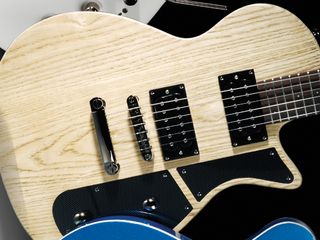
Adam Black Libra UK £399
Britain, Britain, Britain… land of high production costs, overpaid workers and punitive tax rates. As such, it’s no surprise that relatively few axes are made in this green and pleasant land, and a big one that Adam Black has built the Libra from its Essex HQ for £399.
But should we bestow our royal appointment on it? Forget the British build: it’s bulletproof, but not noticeably better than a modern Far Eastern one.
Of more interest is the Libra’s mix-and-match spec. It looks like a Les Paul-inspired bruiser, but features a Fender-style ash body and maple bolt-on neck. You pick it up expecting to play meaty mid-tempo rock riffs, but are thrown a loop by the two-octave neck and 25.5-inch scale.
Inevitably, given the wood, the humbuckers don’t deliver the dark ‘boom’ you’d get if they were sat in a brick of mahogany, but that’s kinda refreshing - it’s bright, jangly and rich, a good halfway house. Similarly, the filth is a bit more wholesome than Slash fans might demand, but it’s anything but boring.
Verdict
Only a plank would buy a guitar solely because of its birthplace. Fortunately, the Libra’s qualities run deeper than a stiff upper lip. In a price bracket where imagination is thin on the ground, this is a memorable axe that plays fast and loose with spec sheet conventions, and to generally good effect, as long as you’re not expecting the bottom-heavy swagger of a textbook singlecut.
4 out of 5
Pros: Quirky, build, memorable.
Cons: Lack of mahogany warmth.
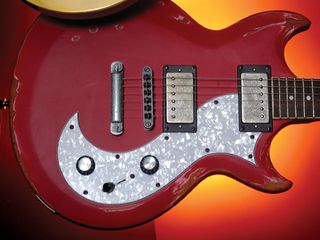
Spear NSG-Relic £329
Thanks to our modern lifestyles, nobody has time to chip a guitar organically over the course of six world tours anymore. Enter Spear Guitars with the new NSG-Relic: a battle-scarred, designer-scuffed warhorse that they’ve kicked about so you don’t have to.
The spec’s been around the block too (twin ’buckers, mahogany body, set neck), making this a guitar that rock nostalgists should love. To paraphrase Howlin’ Wolf, the NSG-Relic is built for comfort, baby, it ain’t built for speed.
Lug this hefty brute from its stand and the weight is reassuring; seize the neck and the profile is the anti- Jackson; tickle the fretboard and you’ll find yourself pulling out expressive (rather than flashy) techniques like lazy bends and vibrato.
OK, the weight distribution means it has a slight tendency to pull south, but you’ll get used to the vibe. Besides, that bulk is a big factor in this axe’s characterful tone, with the mahogany fusing with quality ’buckers to deliver a dark, soulful roar that sustains for yonks.
Verdict
Spear impressed with its higher-end Tomcat models; the Relic proves it can get down and dirty too. Soulful tone, beefy handling and road-worn looks - and when the only criticism is a subjective quibble over how it hangs on a strap, you know you’re doing well for £329.
There’s no shortage of rivals, but the Relic has its own vibe and deserves a test-drive.
4 out of 5
Pros: Beefy beast with tone to match.
Cons: Pulls down a little.
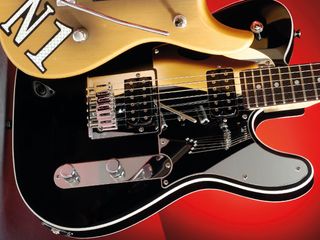
Squier J5 Telecaster £379
Holy cow! That was the reaction to John 5’s first signature Tele, complete with Bigsby, bespoke pickups and a headstock you could paddle a canoe with. Six years later, the Squier J5 seems good value compared to the £849 original. But with a standard headstock, no vibrato and stock pickups, we can’t help but notice our crestfallen face in the mirrored pickguard.
OK, maybe we’re being unfair: plenty of good stuff has made it onto the J5, from the monster sustain of the heavy alder body to the flowing ‘C’ profile of the meaty maple neck.
But it’s ironic that 5’s most idiosyncratic feature is one we could live without. Sure, the twin volume controls let you perform 5’s trademark ‘kill’ effect, but no tone dial means it’s impossible to tweak the humbuckers, which can sound a bit woolly for his trademark ‘shred-grass’ (tellingly, his own Fender has a single-coil at the neck), and rely on you solving the problem with your amp’s EQ settings.
Verdict
“This is just like my main Telecaster, exactly,” says 5 - but that’s not exactly true. If we hadn’t had our heads turned by the original, we’d probably be giving an unreserved thumbs-up to the watertight playability and meaty, unorthodox Telecaster sounds of the Squier J5, especially in light of the ultra-competitive price tag.
But in reality we have, and so we give this axe a respectful tip of the hat, bid it farewell and move on to our next A-lister.
4 out of 5
Pros: Big sounds and solid feel.
Cons: It’s lost its original spark.
Buy: Squier J5 Telecaster is currently available from Andertons Music Co.
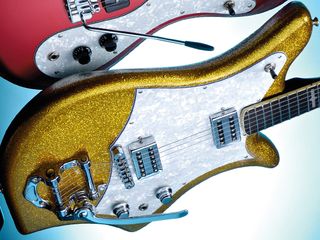
Eko 700 £329
Eko began designing and making guitars in Italy during the late ‘50s and while some of the guitars it produced are clearly influenced by more famous models, it also manufactured a few original designs. The 700 is one of the more recognisable models, and now it’s back.
Once your retinas have recovered from the dazzlingly intense finish of this metallic gold axe, you’ll notice one thing in particular: its weight. Its basswood body is heavy, and this is reflected in its fat tone, spurred on by the humbuckers.
There’s only one volume and one tone knob, but the 700 delivers some tasty lower midrange tones from the neck pickup, which are perfect for churning out some meaty sounding riffs.
The BB vibrato is a fitting inclusion, but it doesn’t seem as stable as some of the roller style vibratos we’ve seen on other models lately.
Verdict
Aesthetically, the 700 is probably more polarising than many, and is sure to divide opinion. Accordingly, you’ll either love or hate the large cutaway at the back or the lower bout, but it doesn’t affect the performance. On a lighter bodied guitar, that large headstock could have become top heavy, but whether it’s lap-bound or on a strap, the 700 balances nicely.
So, if you can lean towards the heavier end of the vintage spectrum then this one will float your boat.
4 out of 5
Pros: Big tone, finish, good value.
Cons: The body is quite heavy.
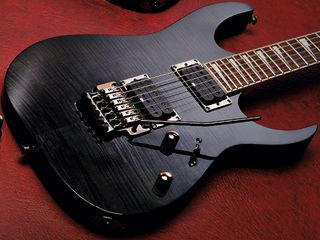
Ibanez RG320 £399
Think ‘Ibanez’ and you’ll doubtless envisage a hirsute virtuoso pulling on a whammy bar with his teeth. So is it any wonder we expected superior performance from the RG320? Ignore the Ibanez blurb (“an army stands before the gates of the castle… in their hands they clutch their timeworn axes”) and drill down into a spec that makes a mockery of the RG320’s miserly price.
Basswood is a solid base for an unspectacular body design, but flair points are clawed back via the Wizard II neck, twin Infinity ’buckers and the Edge III vibrato that has wowed TG in the past.
Ibanez guitars are born to shred, and the Edge vibrato is designed to facilitate this. Skimming along the length of the Wizard II neck is totally natural and the Edge feels like an extension of your arm, soaking up the abuse to deliver some spectacular sonic mind-trickery.
Verdict
The RG320 is no slouch in the tone department. Thanks to the trademark Ibanez pickup switching system, it’s possible to split the Infinity humbuckers any which way: alongside the buzzsaw tones you’d expect, we were able to dig out funky quacks that recalled a good Strat.
4 out of 5
Pros: Value, versatile, shred-friendly.
Cons: Slightly derivative looks.
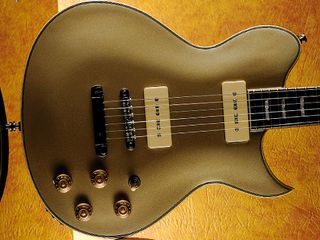
Washburn WI66PROG £389
The planet might be in economic freefall, but we’ll be OK as long as Washburn keeps cranking out the Idol Series. We’ve seen that doublecut body a squillion times, but this is the only Idol to feature P-90s.
There is a distinctly classic vibe resounding from the WI66PROG, which combines a mahogany body and set neck with the traditional pairing of a 24-carat carved top and double soapbars. That said, it ain’t 1952 anymore, and those P-90s aren’t all they seem. In fact, they’re ‘stacked’ humbuckers to eliminate noise, and can be split with the push-pull tone controls to achieve the characteristic biting tone of the P-90s.
If he wasn’t dead, Johnny Thunders would argue that P-90s belong in pint-sized pocket-rockets that you throw around the stage. The WI66PROG isn’t like that at all. It’s heavy and cumbersome, with a fat neck and a bend-friendly board that means you often start playing like Jimmy Page. That’s not a bad thing, but as Clash fans, we couldn’t help craving a bit more snot-rag attitude.
Verdict
The hum of old-school P-90s is frustrating, and while these stacked soapies solve that problem, there’s an argument that they don’t bite like regulars.
The clean tone is smooth and classy, well suited to vintage licks with a little gain, but you have to split the coils and hit it hard to get a sneer (even then, it’s a little polite). That’ll turn some players on and others off. Hit the dealer to see which camp you’re in.
4 out of 5
Pros: Price, physical feel, versatile tone.
Cons: Other axes have more ’tude.
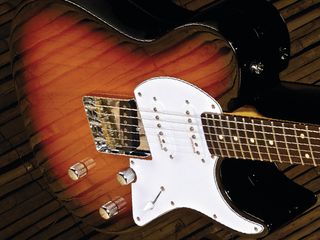
Vintage Advance AV2 S3 £399
We’ve all had the five-pint conversation about grafting Angelina Jolie’s head onto Jordan’s body. This is the guitar equivalent, with a Strat-esque trio of pickups astride a Tele-ish singlecut.
Vintage has sure pushed the envelope since letting designer Trev Wilkinson loose on the Advance Series in 2006. Take the innocuous-looking AV2 model, which manages to raise eyebrows with a chambered alder body (“this gives it a lighter tone, a little more acoustic”), a thumb cutaway (“so it’s easier to play the top frets”), a sustain-boosting bubinga heel on the back of the neck, and a stacked bridge single-coil that’s made fatter or thinner via a roll control.
If the AV2’s chambered body is open to debate, then the neck is less divisive, offering a slip-sliding platform that’s as good as anything here.
Elsewhere, it’s mostly good news, with the bubinga heel a reassuring presence, the thumb notch actually working and the roll control unlocking a cracking array of clean voices (even if the neck/middle items are more Strat-sounding than Tele purists might hope).
Verdict
All of which makes the AV2’s slight lack of punch when distorted a let-down - it delivers a racket that’s more ‘watertight’ than truly unforgettable. Give it a road-test before swiping your credit card.
4 out of 5
Pros: Packed full of smart ideas.
Cons: Distorted tone lacks balls.
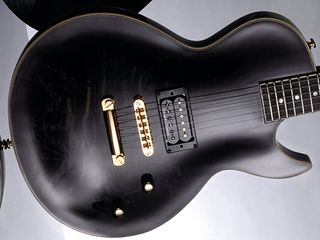
Spear SHL1Q Evil Monkey £379
Spear has been trading since 2005, so it’s tempting to cast it as a plucky young contender. But is the Evil Monkey just aping the old classics?
The Evil Monkey is a compelling fusion of vintage and modern, with the mahogany body and quilted maple top tipping a hat to tradition, but the graphic and standalone Seymour Duncan JB humbucker making us want to thrash it in a punk garage band.
The absence of a neck item has shaved pounds off the price (Spear reckons most rock players sit on the bridge anyway), but we were concerned it might cost us sonic versatility.
Bulletproof and finished with attention to detail, it doesn’t feel like a £379 electric. That said, if you play a lot of rhythm and want to flesh out your band’s sound, the lack of neck ’bucker means you’ll need an amp with good bass response to counteract it. So it’s a good thing the Seymour Duncan JB at the bridge is a cracker, turning in a ferocious bite that combines with the endless sustain for an amazing lead tone.
Verdict
If you want a traditional singlecut feel, you’ll love the Monkey’s monstrous weight, satisfying neck and slab-like dimensions. It’s not an obvious choice for noodling, but if you’re a player in the Slash tradition and want to peel off tasty bends and chunky mid-tempo solos, give it a spin.
4 out of 5
Pros: Value, classic feel, biting tone.
Cons: The lack of a neck ’bucker.
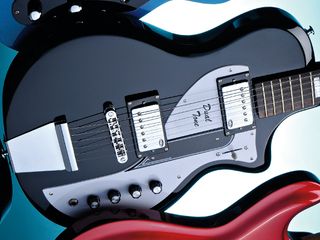
Eastwood Supro Dual Tone £399
Supro was originally part of the Valco parent company that also owned National. The first Supro Dual Tone had two oversized single-coils, but Eastwood’s reissue comes with a pair of dual-coil pickups.
Apart from this, the design is pretty faithful to the original, with a volume and tone control for each pickup and a three-position blade selector switch. A quick look at the spec tells you that the Dual Tone follows a fairly standard singlecut blueprint. A slab body (basswood in this case) with two humbuckers and the usual controls, but if it ain’t broke…
Amping up this unassuming critter gives us a mixed reaction. The tone doesn’t seem as chunky as you might first expect; the vintage voicing of the pickups and the basswood body makes for a less meaty sound but that’s not really a bad thing.
With a bit of crunch, the Dual Tone works perfectly for bashing out some growly punk powerchords, and plugging it through a vintage style fuzz pedal places us squarely in garage rock territory.
Verdict
Had this been a test about attitude, the Supro would have gobbed in the others faces and unapologetically swaggered off with the prize, but we’re thinking in terms of versatility. It definitely appeals to singlecut fans though, who would gladly part with the cash.
4 out of 5
Pros: Loads of vibe, range of tones.
Cons: Not as much meat as some.
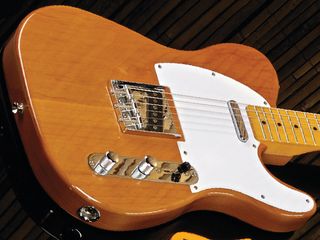
Sparrow Twangmaster Pro £329
Given that Canadian newcomer Sparrow is staffed by 10 nostalgists with ceiling-scraping quiffs who profess a love of “classic ‘50s greasy stuff”, the omens are good for this guitar.
The more expensive Twangmaster Boss and Kustom models boast aftermarket pickups, but the £329 Pro employs the same tonewoods and looks like better value to us.
With an ash body, it’s actually more faithful to the Teles of the ‘50s than modern Fenders, while Sparrow is keen to flag up the adaptable voicings of its own-brand single-coils: “Go from twang to bang with the flick of a switch… The Twangmaster can be bright and jangly with the traditional rich bell tone, or snarl, bark and bite like a hellcat.”
A couple of quibbles. First, our Twangmaster looks a little anaemic without the optional finish. Second, the bridge single-coil on this specific model is a bit wonky (probably why its output is noticeably quieter). Both are outweighed by a great pound-for-pound performance.
Verdict
True to the Tele mission statement, this is uncluttered simplicity par excellence, with an accommodating body, neck profile and fingerboard that make good players soar. Tonally, the bridge singlecoil redefines ‘twang’ - you’ll almost want to soften it with your amp’s bass EQ - but the neck item makes good on claims of “rich bell tone”, with a droolsome voice for rhythm. You could do a lot worse.
4 out of 5
Pros: Characterful voice, biting tone.
Cons: Bridge can be shrill.
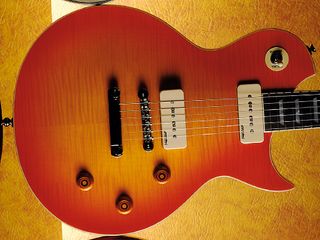
Vintage Advance AV1P £349
Respect to Vintage, but its standard axes are very much ‘inspired’ by our ‘50s faves. Launched in 2006 with Trevor Wilkinson at the helm, the Advance Series hopes to push the envelope a little further.
Trev describes the design process as “a labour of love”. We assume the sleepless nights were caused not by the maple-topped mahogany body (which is pretty standard, albeit with a quirky upper cutaway), but the innovative ‘roll control’, which claims to transform each stacked P-90 from humbucker to a singlecoil by degrees.
Weird science, but does it rock? At £349, the AV1P might seem a breadline option, but the wedge goes a long way. While the format and execution of this model won’t scare the horses, and it doesn’t balance that well on the knee, it does gets close to a LP vibe with the chunky neck and body.
Verdict
The neck profile is solid for rock and blues, though in a competitive price range it’s not the most memorable. The stacked P-90 format costs the AV1P a little authenticity, but the versatility of the roll control makes up for this, gradually slimming your tone from a fat and full humbucker roar to a twitchy single-coil snap.
Granted, there isn’t the underlying class of its rivals, but the rough ’n’ ready vibe of the AV1P is strangely endearing. We’ve played better, but not without spending more.
4 out of 5
Pros: Superb value and versatility.
Cons: There are stronger tones.
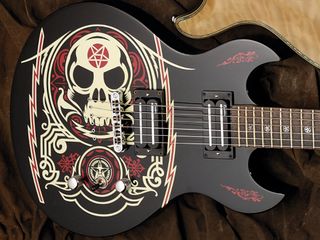
Washburn SI61 £349
Scott Ian can’t get enough of his US Custom Shop SI81: “This guitar is exactly what I’ve been looking for - it’s evil and it plays fuckin’ awesome.” Let’s hope the cheaper SI61 rocks too…
Washburn treats mid-price punters well, so while realists won’t be surprised to find the SI81’s graded timbers and premium hardware missing in action, they’ll be satisfied with the features the SI61 retains.
Visually, there’s actually more of Ian’s influence here, with an Obey graphic and Anthragram fret inlays giving off a meaner vibe than the US model’s po-faced maple top and parallelograms.
Look past the Obey graphic and you’ll realise the SI61 follows familiar contours, costing it points in the originality stakes, but clawing them back if you love the classic doublecut vibe. It’s easy to hit the top frets and to fret notes with speed and precision, which will suit Anthrax fans looking to mimic Ian’s percussive down-picking.
Verdict
We’d concur with the man himself - it plays frickin’ awesome. Following a rail format, the SI61’s twin Egnater humbuckers stand out in this group, offering a bone-crunching bottom-end that’s perfect for Among The Living speed-riffing, but that’s less convincing for more melodic styles.
Still, if you’re considering this axe it’s because you want to nail Ian’s vibe, and if that’s the criteria, mission accomplished.
4 out of 5
Pros: Perfect for Scott Ian-style riffing.
Cons: Not for non-Anthrax fans.
Buy: Washburn SI61 is currently available from Thomann
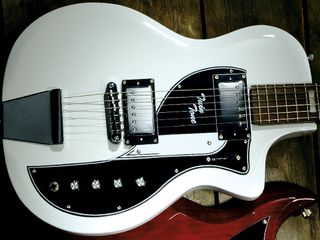
Airline Twin Tone £360
We’ve reviewed a lot of Eastwood-made guitars. We fell in love with the Airline Tuxedo, Coronado, Town and Country Deluxe, H44 and the GP. The Airline Twin Tone is another corker.
This is based on the classic ‘50s Supro Dual Tone model played by guitarists like Jimmy Page and Link Wray - yep, they didn’t just play Danelectros. You can see Joe Perry playing his Supro Dual Tone in the video for Aerosmith hankyfest I Don’t Want To Miss A Thing.
Our budget Airline offers all that rock star vibe on a busker’s budget. The Airline Twin Tone feels like a vintage guitar. It doesn’t quite have the easy playability of most modern guitars but, to be honest, that only adds to its old-school vibe. You might not agree.
Tonally, this guitar packs a real punch thanks to its beefy sounding humbuckers. The bridge unit in particular pushed our amp into a thick overdrive that we couldn’t get enough of.
Verdict
That tonal power makes the Twin Tone a cool alternative to the Epiphone Les Paul or any of its many derivatives. If you’re not experienced with old-school guitars you might take a bit more convincing, but you may just fall in love like we have. Pass the tissues…
3 out of 5
Pros: Looks, rocking tone.
Cons: Not quite as playable.
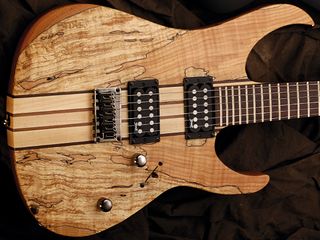
Spear Gladius SP £329
Established in 2005, Spear might not be a household name, but you’re not Posh Spice so stop worrying about labels and feel the spec. This is not so much a guitar as a tree with strings...
The Gladius combines a solid mahogany body with spalted maple top, throws in a five-ply maple and mahogany thru neck and stretches our grins even further with twin Monster Pole humbuckers whose coils can be split with a five-way selector.
Anyone with eyes should already be hot for the Gladius SP, whose credible tone-woods and natural beauty convey the vibe of a high-end boutique instrument. But it’s not until you retract your tongue that you realise this model has also been honed to perfection, with the expansive cutaways and speedy unfinished neck making it handle like a go-faster 24-fret Fender Stratocaster.
Verdict
Handling is one thing and tone another, but here the Gladius scores again. As you’d imagine from the eclectic timbers and thru-neck, there’s huge sustain and tonal character on the table, and these benefits are complemented by the class of the PAFs. The option to split the coils is clever, but we left them in one piece to deliver a tone that is fat and thick.
5 out of 5
Pros: One-of-a-kind looks, tone.
Cons: We’re keeping quiet.
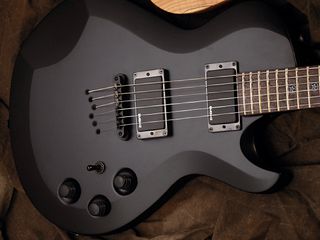
Cort EVL-Z4 £329
For all you aspirant rockers on a budget, it’s only a matter of time before the sales assistants suggest a Cort. And if you’re wearing Mortiis makeup, a crucifix and biker boots, they’ll probably show you this one.
Don’t be fooled by novelty trimmings like the coffin truss rod cover and pentagon inlays - Cort’s EVL-Z4 is backed up by a serious spec. A solid mahogany body and a bolted maple neck are always good to see, but the main event is undoubtedly the twin EMGs. It’s time to wake the dead…
The body shape is clichéd fare, but Cort’s judicious use of contours and bevels for your beer belly and picking arm mean the Z4 model is as accommodating as most. As a playing experience, it feels tight and compact, offering a comparable pocket-rocket vibe to a Les Paul Junior but with zippier play due to the C-profile of the neck.
It’s a shame the fret access isn’t quite on a par with the doublecuts it’s up against though.
Verdict
For £329, it goes without saying that these are passive EMGs, but that didn’t matter - we still dug out a superb response across the board, with the bridge turning in monster tone for solos and the neck taking care of crunching overdriven rhythm parts.
4 out of 5
Pros: Spooky metal vibe, EMG kudos.
Cons: Fret access could be better.
Buy: Cort EVL-Z4 is currently available from THomann

Italia Mondial Classic £399
The Italia guitars are the brainchild of Trev Wilkinson, British guitar design guru and inventor of the Wilkinson vibrato. Although Italia guitars are not reissues of vintage guitars they are heavily influenced by the weird and wacky pawnshop prizes of the ‘50s and ‘60s.
The Mondial is a clever amalgam of kitsch design ideas that have been updated with modern playability and a pair of beefy sounding pickups. It also features an onboard piezo pickup. Yep, this guitar can produce both electric and acoustic sounds.
The first thing you notice about the Mondial is that the top is made of plastic or ‘Acousti-Glass’. And that white scratchplate is actually part of the body moulding. This guitar is well put together, something you would expect when Mr Wilkinson is involved. Through an amp we found a range of good useable tones, including that bridge-mounted acoustic pickup.
Verdict
Italia makes vintage-style guitars for people who can’t stand the faults of the real deal, and the Mondial sounds good and plays well. The only thing it lacks is a ‘vibe’. It might be named after a Ferrari sports car (or Italian motorcycle legend, either’s fine by us), but the Mondial didn’t quite thrill us in the same way.
But hey, we still think you should give this cool-looking guitar a whirl.
3 out of 5
Pros: Good sound, quality construction.
Cons: No thrills.

Airline Town & Country Deluxe £399
Canadian company Eastwood produces a range of replicas and reissues of ‘50s and ‘60s pawnshop prizes. Take a look on the website and you’ll see such cheesy six-string genius as the Wandre Deluxe, the Hi-Flyer and the Ichiban. We love these guys!
The Airline Town & Country Deluxe is a replica of the vintage guitar played by Jack White in the video for The Raconteurs’ Steady As She Goes. Thanks to Jack’s patronage the original guitars are now worth a small fortune, so Eastwood’s reissue is our only chance of flying on this particular Airline. Yeah, cheers dude…
The Elephant Man would look like a rock star with this guitar round his neck. The three-pickup layout, Licensed Bigsby vibrato and abundance of control knobs on the Airline help this guitar look the absolute business. The only thing we weren’t blown away by was the position of all those knobs. They get in the way a bit, although we did get used to them after a while.
Verdict
Plugged in this guitar will ‘do’ metal, but it’s best suited to scuzzy old rock sounds and ‘50s twang. The playability won’t please shredders, but it’s fine for strummers, surf punks and powerchord fiends. We’d be happy to fly this Airline again. We didn’t get any complimentary nuts, but we did get a kick out of thinking we were as cool as Jack White.
4 out of 5
Pros: Ace looks, twangs beautifully.
Cons: Clumsy knobs.

Washburn N2 £349
Nuno Bettencourt couldn’t get himself arrested when Washburn launched his first signature model in the ‘80s. Then Extreme hit paydirt, his axes went supersonic, and the partnership kept on rolling.
The entry-level N2 pilfers the foundations from Nuno’s USA Custom Shop N4 and packs them into a play-anywhere workhorse. Corners have been cut, but Washburn reckons the vibe remains intact.
Nuno’s guitars have always looked the same - a doublecut design with a reverse headstock, a floating tremolo and a blade humbucker in the bridge. The N2 retains all these features, and though the timbers are cheaper (alder for the body and maple for the bolt neck) you can’t knock the L500 Bill Lawrence pickup, nor the responsive 600S Floyd Rose.
Verdict
There are only 22 frets on this axe, but the physical performance is fast, effortless and perfect for egotists. The neck humbucker delivers thick output and a rounded voice, but Bill’s blade offers the tonal bite that is so important for defined single-note runs, along with more character than you’ll get from most go-faster axes at this price point.
Our one criticism was that the N2 didn’t offer much scope for tweaking… until we pulled the master volume and realised it was also a coil tap!
5 out of 5
Pros: Cool vibe, speedy, punchy tone.
Cons: Only 22 frets?
Liked this? Now read: The best electric guitars under £300 and 17 more cool electric guitars under £300
Connect with MusicRadar: via Twitter, Facebook and YouTube
Get MusicRadar straight to your inbox: Sign up for the free weekly newsletter

Total Guitar is Europe's best-selling guitar magazine.
Every month we feature interviews with the biggest names and hottest new acts in guitar land, plus Guest Lessons from the stars.
Finally, our Rocked & Rated section is the place to go for reviews, round-ups and help setting up your guitars and gear.
Subscribe: http://bit.ly/totalguitar

“The mini humbucker fits into the same sized pickup cavity as a P-90 and delivers low-noise humbucking pickup performance and a slightly brighter and more open tone”: Gibson remixes the Les Paul Special with mini humbuckers

“Exceptional performance, sound, and style at an incredible value.”: Gretsch unveils trio of limited edition Streamliner electrics that offer Bigsby wobble, semi and hollow-bodied rock ’n’ roll mojo for $699

“The mini humbucker fits into the same sized pickup cavity as a P-90 and delivers low-noise humbucking pickup performance and a slightly brighter and more open tone”: Gibson remixes the Les Paul Special with mini humbuckers

“Exceptional performance, sound, and style at an incredible value.”: Gretsch unveils trio of limited edition Streamliner electrics that offer Bigsby wobble, semi and hollow-bodied rock ’n’ roll mojo for $699










